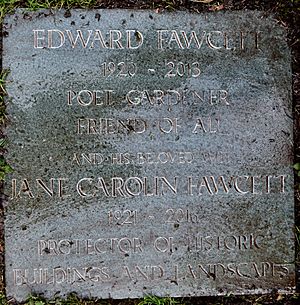Jane Fawcett facts for kids
Quick facts for kids
Jane Fawcett
|
|
|---|---|
| Born |
Janet Carolin Hughes
4 March 1921 |
| Died | 21 May 2016 (aged 95) Oxford, England
|
| Nationality | British |
| Other names | Jane Hughes |
| Occupation | Preservationist, author, codebreaker, singer |
| Known for | Decoding a message, which enabled the Royal Navy to sink the Bismarck |
Jane Fawcett (born Jane Hughes; 4 March 1921 – 21 May 2016) was a clever British codebreaker. She was also a talented singer and worked to save old buildings and places. She became famous for helping to decode a secret message. This message led to the sinking of the huge German warship, the Bismarck. From 1963 to 1976, she was the secretary of the Victorian Society. She also wrote and edited several books.
Contents
Early Life and Education
Janet Carolin Hughes was born on 4 March 1921. Her father, George Hughes, worked for a company called the Goldsmiths’ livery company. Her mother was Margaret Graham.
Jane grew up in London. She went to Miss Ironside's School for Girls and trained to be a ballet dancer. She was even accepted into the Royal Ballet School. But when she was 17, she was told she was too tall to be a professional dancer. This ended her dream of a ballet career.
After that, she went to Zürich in Switzerland to learn German. She then moved to the St Moritz ski resort. After six months, her parents asked her to come home to be a "debutante." This meant she would be introduced to society. Jane found this lifestyle very boring. She was happy when a friend invited her to apply for a secret project at Bletchley Park.
Wartime Service as a Codebreaker
In 1940, when Jane was 18, she joined the secret codebreaking project at Bletchley Park. She was interviewed by a senior codebreaker named Stuart Milner-Barry. Jane joined a group of women known as the "Debs of Bletchley Park." They were called this because many were from wealthy families. They worked in secret on the Enigma project.
Hughes worked in Hut 6, which was a "Decoding Room" only for women. The working conditions were tough. The rooms were dimly lit, poorly heated, and didn't have good air. The women worked long hours under a lot of pressure. In Hut 6, Jane and other women would receive the daily Enigma codes. They would type these codes into special machines called Typex machines. Their job was to figure out if the messages were recognizable German.
Decoding the Bismarck Message
On 25 May 1941, Jane and other women were told about the search for the German battleship Bismarck. This was a very powerful German warship. Soon after, Jane decoded a message about the Bismarck. The message gave its exact location and where it was heading in France. Because of this vital information, the Royal Navy was able to attack the Bismarck. The ship was sunk on 27 May. This was a huge victory for the codebreakers. It showed how important their secret work was.
Jane's work was kept secret for many years. It was only in the 1990s that her story became known. This was because of Britain's Official Secrets Act. Jane said that she and her colleagues felt a bit ashamed of only having worked at Bletchley Park. They felt like "also-rans" compared to the navy heroes. So, when their hard and demanding work finally came to light, it felt overwhelming. She had never told anyone, not even her husband. Her grandchildren were very surprised.
Jane Fawcett was one of the people Michael Smith interviewed for his book, The Debs of Bletchley Park and Other Stories (2015).
Singing Career After the War
Jane's work at Bletchley Park ended in May 1945. After the war, she married Edward Fawcett and took his last name. She then trained at the Royal Academy of Music. For about 15 years, from the end of the war to the early 1960s, she had a successful career as an opera singer. She performed in operas like Scylla et Glaucus and Dido and Aeneas. She also performed as a solo singer.
Architectural Preservation Work
In 1963, Jane Fawcett took an important job at the Victorian Society. This group was started in 1957 to save old buildings and places from the Victorian era. As the society's secretary, she was like the main leader. She worked closely with Sir Nikolaus Pevsner to save many buildings from being torn down.
Jane was sometimes called "the furious Mrs Fawcett." This was because she fought hard with British Rail to save historic railway stations. She played a key role in saving St Pancras station in London in 1967. She also helped save the beautiful gothic Midland Grand Hotel. She also worked to protect many parts of London's Whitehall area from destruction.
Her husband, Edward, also joined in historic preservation work in 1965. He first joined the Garden History Society. Then, in 1969, he started working full-time for the National Trust.
In 1976, Jane Fawcett was given an award called the MBE. After this, she stepped down from her active leadership role. In later years, she taught about preservation at the Architectural Association School of Architecture.
Personal Life and Legacy

Jane Hughes met Edward "Ted" Fawcett during World War II. He was an officer in the Royal Navy. They married soon after. They had two children: Carolin, who became an opera singer, and James, who became a neurologist.
Jane Fawcett passed away at her home in Oxford on 21 May 2016. She was 95 years old. Her memorial service was held at St Peter's Church, Petersham.
Awards and Recognition
- MBE (Member of the Order of the British Empire) in 1976
- Honorary fellow of the Royal Institute of British Architects, 1976

